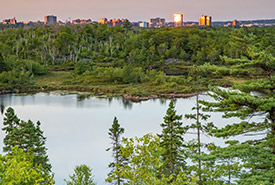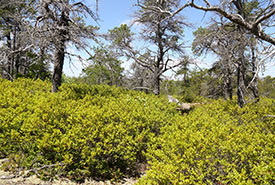Keep Halifax Wild

Colpitt Lake inside the Halifax Wilderness Park (Photo by Adam Cornick)
The international City Nature Challenge was bigger than ever this year, pitting 159 urban centres in a competition to identify the most diversity of living things, from New York to Hong Kong, Athens to Cape Town. This year was particularly exciting because, for the first time ever, Canadian cities were in the game. Richmond, BC; Calgary, Alberta, and Halifax, Nova Scotia, each aimed to scour the wild spaces within their borders for every example of local life. As a proud Atlantic Canadian, I went to Halifax.
At first I was intimidated by Calgary’s population density and Richmond’s rich, western biodiversity, but I needn't have been concerned, because more so than most metropolises, Halifax has a wild side.
Within the Halifax Regional Municipality there are hemlock groves as large as any in the Maritimes, world-class conglomerations of lichen, and ecosystems whose combination of living things cannot be found anywhere else on Earth. All of these are contained within urban parks like Hemlock Ravine, Blue Mountain Birch Cove, Point Pleasant and, most notably, the Nature Conservancy of Canada’s (NCC’s) up-and-coming project: the Halifax Wilderness Park.
Related content
NCC rarely works within city limits, dedicating its donated dollars instead to the protection of intact wilderness beyond the reach of suburbs and urban sprawl. But an area of wilderness on Halifax’s southwest edge represented a special case. The area features Acadian forest, two lakes, exposed granite bedrock and a globally significant jack pine/broom crowberry barrens, all of which, by some miracle, remained undeveloped.

Jack pine (Photo by Mike Dembeck)
Shaw Group Ltd, the landowner, was approached by NCC and was willing to sell the 380 acres (154 hectares) for a park, instead of holding it for a future development. On top of that came enthusiastic community support, and the Halifax Regional Municipality’s willingness to pay half of this property’s $8-million price tag.
NCC’s Nova Scotia team has been working toward establishing this park for four years now, fundraising for its share of the park cost with its Keep Halifax Wild campaign, and its progress has been extraordinary. By the time of the City Nature Challenge in April, NCC was a mere $400,000 away from establishing the Halifax Wilderness Park. Once this amount is raised, hopefully by fall, the trails will be marked, a parking lot established and the park officially opened, and anyone with a bus pass will be able to reach its trailhead.
When I laid eyes on this forthcoming park in the final days of the City Nature Challenge, the trees were still bare, but it was full of life. It contributed to Halifax citizens — myself included — being able to more than double the scores of Calgary and Richmond. I had the privilege of walking the future Halifax Wilderness Park’s rugged trails, blazed by locals in urgent need of a natural fix. Many trails were rough, leading over logs fallen across streams or steep upwellings of rock. Within minutes I forgot that there was a city beyond the trees; on occasion I caught sight of the steel and glass spires of downtown rising over a sublime near horizon of trees, jarring me with the contrast. Several times I confused the sounds of suburb construction with those of a veracious woodpecker.
This area is part of the reason Halifax may still call itself wild, and why in the City Nature Challenge, we gave Calgary and Richmond such a thrashing. In total, Halifax had 237 participants who identified 911 species across 7,647 observations, beating the rest of Canada combined. Better luck next year, folks!
Something like 80 per cent of Canadians live in cities these days, a staggering figure that has exploded in my own lifetime. Promises of employment, entertainment and diversity of people, grocery stores and restaurants drew most of a nation into the concrete jungle. But now that the dust has settled, we find ourselves pining for the world we left behind, where undisturbed wilderness could help us spend a Saturday afternoon or escape the stresses of modern living. Halifax is fortunate to have some beautiful wild corners left, and thanks to NCC’s leadership, 380 acres (154 hectares) of abundant nature is being protected for all to enjoy in the Halifax Wilderness Park.
To learn more about the Halifax Wilderness Park or to donate, visit keephalifaxwild.ca.


